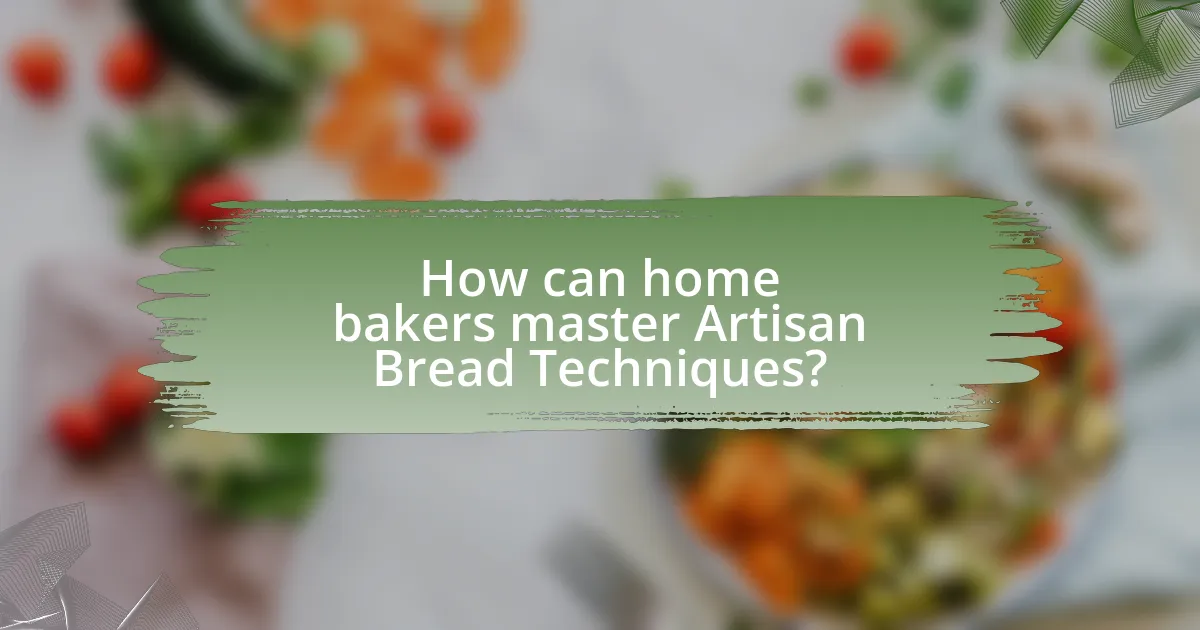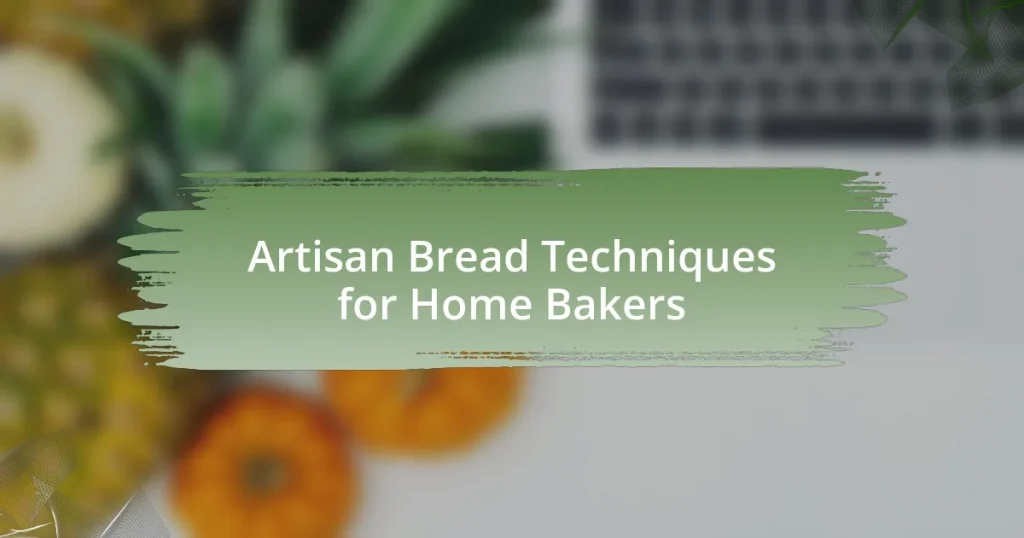Artisan Bread Techniques for Home Bakers focus on high-quality ingredients, long fermentation times, and precise shaping and scoring methods to achieve superior flavor and texture in bread. Key differences from regular bread-making include the use of minimal ingredients, natural leavening agents, and extended fermentation periods that enhance complexity. Essential tools such as a digital kitchen scale, baking stone, and Dutch oven are highlighted for their roles in improving the baking process. The article also emphasizes the importance of mastering fermentation, kneading, and shaping techniques to produce artisan-quality bread at home, while addressing common mistakes and best practices for storage.

What are Artisan Bread Techniques for Home Bakers?
Artisan bread techniques for home bakers include using high-quality ingredients, employing long fermentation times, and mastering shaping and scoring methods. High-quality flour, water, salt, and yeast are essential for developing flavor and texture. Long fermentation, often through methods like cold fermentation or using a preferment, enhances the bread’s complexity and crust. Proper shaping techniques, such as the envelope fold or bench rest, contribute to the bread’s structure, while scoring allows for controlled expansion during baking. These techniques are supported by the principles of bread science, which emphasize the importance of gluten development and fermentation in achieving artisan-quality results.
How do Artisan Bread Techniques differ from regular bread-making methods?
Artisan bread techniques differ from regular bread-making methods primarily in their emphasis on high-quality ingredients, longer fermentation times, and hands-on shaping. Artisan methods typically utilize minimal ingredients, focusing on flour, water, salt, and natural leavening agents, which enhances flavor and texture. In contrast, regular bread-making often employs commercial yeast and may include additives for speed and consistency.
Additionally, artisan bread relies on longer fermentation periods, sometimes extending to several hours or even days, allowing for the development of complex flavors and improved digestibility. Regular bread-making methods usually prioritize quicker processes, resulting in less depth of flavor. The shaping of artisan bread is often done by hand, promoting unique crust and crumb structures, while regular methods may use machines for uniformity. These distinctions highlight the craftsmanship and attention to detail inherent in artisan bread-making.
What unique ingredients are commonly used in Artisan Bread Techniques?
Unique ingredients commonly used in Artisan Bread Techniques include high-protein flour, sourdough starter, and specialty grains like spelt or rye. High-protein flour, typically with a protein content of 12-14%, enhances gluten development, resulting in a chewier texture and better rise. Sourdough starter, a natural leavening agent, introduces complex flavors and improves shelf life due to its acidity. Specialty grains, such as spelt or rye, contribute unique flavors and nutritional benefits, enriching the overall profile of the bread. These ingredients are essential for achieving the distinctive characteristics associated with artisan bread.
How does the fermentation process vary in Artisan Bread Techniques?
The fermentation process in Artisan Bread Techniques varies primarily in duration, temperature, and the type of leavening agent used. Different techniques, such as poolish, biga, and sourdough, utilize varying fermentation times, with some requiring only a few hours while others may take several days. For instance, sourdough fermentation involves a longer process due to the natural yeast and bacteria present in the starter, which enhances flavor and texture. Additionally, temperature plays a crucial role; warmer environments accelerate fermentation, while cooler temperatures slow it down, allowing for more complex flavor development. These variations are supported by the fact that longer fermentation times generally lead to improved gluten development and flavor complexity, as evidenced by studies on bread quality and fermentation impact.
Why should home bakers learn Artisan Bread Techniques?
Home bakers should learn Artisan Bread Techniques to enhance their baking skills and produce high-quality bread with superior flavor and texture. Mastering these techniques allows bakers to understand fermentation, hydration, and shaping, which are crucial for achieving the characteristic crust and crumb of artisan bread. Research indicates that artisan bread, made with traditional methods, often contains fewer additives and preservatives, resulting in a healthier product. Additionally, studies show that the process of slow fermentation improves the bread’s digestibility and nutritional profile, making it a more wholesome choice for consumers.
What are the benefits of baking artisan bread at home?
Baking artisan bread at home offers several benefits, including enhanced flavor, control over ingredients, and cost savings. Home bakers can create unique flavors and textures by experimenting with various flours, hydration levels, and fermentation times, resulting in a product that often surpasses store-bought options. Additionally, baking at home allows individuals to avoid preservatives and additives commonly found in commercial bread, promoting healthier eating habits. Financially, making artisan bread at home can be more economical than purchasing specialty loaves, especially when considering the price of high-quality ingredients.
How does mastering these techniques enhance baking skills?
Mastering artisan bread techniques significantly enhances baking skills by providing bakers with a deeper understanding of fermentation, dough handling, and flavor development. These techniques, such as proper kneading, shaping, and proofing, allow bakers to create bread with improved texture and taste. For instance, understanding the science behind gluten development enables bakers to achieve the desired rise and crumb structure, resulting in a more artisanal product. Additionally, techniques like using a preferment or sourdough starter can enhance the complexity of flavors, making the final bread more appealing. This knowledge not only improves the quality of the bread but also boosts the baker’s confidence and creativity in the kitchen.

What are the essential tools for Artisan Bread Techniques?
The essential tools for Artisan Bread Techniques include a high-quality stand mixer, a digital kitchen scale, a bench scraper, a proofing basket, a baking stone or steel, a Dutch oven, and a thermometer. These tools facilitate precise measurements, effective mixing, proper dough handling, and optimal baking conditions. For instance, a digital kitchen scale ensures accurate ingredient ratios, which is crucial for achieving consistent results in bread-making. A baking stone or steel helps retain heat, creating a better crust, while a Dutch oven traps steam, enhancing the bread’s texture. Each tool plays a vital role in the artisan bread-making process, contributing to the overall quality of the final product.
Which tools are necessary for successful artisan bread baking?
Successful artisan bread baking requires a few essential tools: a mixing bowl, a bench scraper, a kitchen scale, a proofing basket, a baking stone or Dutch oven, and a sharp blade or lame for scoring. These tools facilitate the precise measurement of ingredients, effective dough handling, proper fermentation, and optimal baking conditions. For instance, a kitchen scale ensures accurate ingredient ratios, which is crucial for achieving consistent results in bread texture and flavor. A baking stone or Dutch oven helps create the ideal steam environment, promoting a crispy crust. Each tool plays a vital role in the artisan bread-making process, contributing to the overall quality of the final product.
What role does a baking stone play in Artisan Bread Techniques?
A baking stone plays a crucial role in Artisan Bread Techniques by providing a consistent and high heat source that mimics the conditions of a traditional brick oven. This high heat allows for better oven spring, resulting in a crusty exterior and a soft, airy interior. The stone absorbs moisture from the dough, which enhances the crust’s texture and flavor during baking. Studies have shown that using a baking stone can improve the overall quality of bread, as it helps achieve the desired Maillard reaction, which is responsible for the browning and flavor development in baked goods.
How important is a kitchen scale in measuring ingredients?
A kitchen scale is crucial for accurately measuring ingredients in baking, particularly for artisan bread. Precision in ingredient measurement directly affects the dough’s hydration, fermentation, and overall texture. Studies show that using weight rather than volume can lead to more consistent results; for example, 1 cup of flour can vary significantly in weight depending on how it is scooped. This variability can result in differences in the final product, making a kitchen scale an essential tool for achieving reliable outcomes in bread-making.
What specialized equipment can improve the artisan bread-making process?
Specialized equipment that can improve the artisan bread-making process includes a stand mixer, a digital kitchen scale, a proofing basket, a baking stone, and a Dutch oven. A stand mixer facilitates thorough mixing and kneading of dough, ensuring consistent gluten development. A digital kitchen scale allows for precise measurement of ingredients, which is crucial for achieving the desired dough hydration and texture. A proofing basket, or banneton, helps shape the dough and supports its structure during the final rise. A baking stone retains heat and provides a consistent baking surface, while a Dutch oven creates a steamy environment that enhances crust formation. These tools collectively contribute to better texture, flavor, and overall quality of artisan bread.
How does a Dutch oven contribute to better crust formation?
A Dutch oven contributes to better crust formation by creating a controlled, humid environment during baking. This humidity allows the bread to expand fully before the crust sets, resulting in a lighter, airier texture. The heavy cast iron construction of a Dutch oven retains heat effectively, ensuring even cooking and promoting Maillard reaction, which enhances browning and flavor development in the crust. Studies show that baking bread in a covered vessel can increase oven spring and improve crust quality compared to open baking methods.
What are the advantages of using a bench scraper and dough whisk?
The advantages of using a bench scraper and dough whisk include improved efficiency and enhanced dough handling. A bench scraper allows bakers to easily lift, divide, and transfer dough without sticking, which minimizes mess and saves time during the baking process. The dough whisk, designed with a unique shape, effectively combines ingredients while incorporating air, leading to a lighter texture in the final product. These tools streamline the mixing and shaping processes, making them essential for achieving consistent results in artisan bread baking.

How can home bakers master Artisan Bread Techniques?
Home bakers can master Artisan Bread Techniques by focusing on key practices such as understanding fermentation, using high-quality ingredients, and perfecting kneading and shaping methods. Fermentation is crucial; it develops flavor and texture, with techniques like bulk fermentation and cold fermentation enhancing the bread’s complexity. High-quality ingredients, including bread flour with a higher protein content, contribute to better gluten development, which is essential for structure. Additionally, mastering kneading techniques, such as the stretch and fold method, and shaping techniques, like the boule or batard, ensures proper dough handling and final shape. These practices are supported by baking science, which shows that proper fermentation and ingredient selection significantly impact the final product’s quality.
What are the key steps in the artisan bread-making process?
The key steps in the artisan bread-making process include mixing, fermentation, shaping, proofing, baking, and cooling. Mixing involves combining flour, water, salt, and yeast to create a dough. Fermentation allows the dough to rise and develop flavor, typically lasting several hours. Shaping involves forming the dough into its final shape, which is crucial for structure. Proofing is the final rise before baking, ensuring the dough is light and airy. Baking transforms the dough into bread, creating a crust and enhancing flavor through Maillard reaction. Finally, cooling allows the bread to set, making it easier to slice and improving texture. Each step is essential for achieving the desired quality and characteristics of artisan bread.
How do you properly mix and knead dough for artisan bread?
To properly mix and knead dough for artisan bread, begin by combining flour, water, salt, and yeast in a bowl until no dry flour remains. This initial mixing ensures that all ingredients are hydrated and evenly distributed. After mixing, transfer the dough to a floured surface and knead it by pushing it away with the heel of your hand, folding it back over itself, and rotating it a quarter turn. Knead for about 10-15 minutes until the dough becomes smooth and elastic, which indicates proper gluten development. This process is essential because gluten provides the structure needed for the bread to rise and maintain its shape during baking.
What techniques are used for shaping and scoring the dough?
Techniques used for shaping and scoring dough include the bench rest, shaping into rounds or batards, and using a lame for scoring. The bench rest allows the gluten to relax, making the dough easier to shape. Shaping involves folding and tucking the dough to create surface tension, which is essential for a good rise. Scoring, performed with a lame, creates controlled slashes on the dough’s surface, allowing for expansion during baking and enhancing the bread’s appearance. These techniques are fundamental in artisan bread making, as they influence the final texture and crust of the bread.
What common mistakes should be avoided when baking artisan bread?
Common mistakes to avoid when baking artisan bread include not measuring ingredients accurately, neglecting proper fermentation times, and failing to preheat the oven adequately. Accurate measurement ensures the right balance of flour, water, and yeast, which is crucial for achieving the desired texture and flavor. Proper fermentation times allow the dough to develop flavor and strength; under-fermentation can lead to dense bread, while over-fermentation can cause the dough to collapse. Additionally, preheating the oven ensures that the bread bakes evenly and develops a good crust, as a hot oven is essential for the initial rise known as “oven spring.”
How can improper fermentation affect the final product?
Improper fermentation can lead to undesirable characteristics in the final product, such as off-flavors, poor texture, and reduced volume. When fermentation is insufficient, the dough may not develop the necessary gluten structure, resulting in a dense and heavy loaf. Conversely, over-fermentation can cause the dough to become overly acidic, leading to a sour taste and a weakened structure that collapses during baking. Research indicates that optimal fermentation times are crucial for achieving the desired balance of flavor and texture in artisan bread, as evidenced by studies showing that well-timed fermentation enhances the development of beneficial compounds like organic acids and alcohols, which contribute to the bread’s overall quality.
What are the signs of over-proofing or under-proofing dough?
The signs of over-proofing dough include a dough that has expanded excessively, resulting in a weak structure that collapses easily when handled. This occurs because the yeast has consumed most of the sugars and produced too much gas, leading to a loss of elasticity. In contrast, under-proofing is indicated by a dough that has not risen sufficiently, appearing dense and lacking volume, which happens when the yeast has not had enough time to ferment and produce gas. Both conditions can negatively affect the final texture and flavor of the bread.
What tips can help home bakers achieve the best results?
To achieve the best results in home baking, bakers should focus on precise measurements, proper ingredient temperatures, and effective kneading techniques. Accurate measurements ensure the right balance of ingredients, which is crucial for the chemical reactions that occur during baking. Using room temperature ingredients, particularly butter and eggs, promotes better emulsification and texture. Additionally, kneading dough adequately develops gluten, which is essential for the structure of artisan bread. Research indicates that proper gluten development can significantly enhance the bread’s rise and texture, leading to a more desirable final product.
How can temperature control improve the baking process?
Temperature control significantly enhances the baking process by ensuring consistent heat distribution, which is crucial for proper dough fermentation and baking. When bakers maintain optimal temperatures, yeast activity is maximized, leading to better rise and texture in the bread. For instance, a study published in the Journal of Food Science indicates that maintaining a temperature around 75°F (24°C) during fermentation can double yeast activity compared to lower temperatures, resulting in a lighter and airier loaf. Additionally, precise temperature management during baking helps achieve the Maillard reaction, which is responsible for the desirable crust color and flavor, further improving the overall quality of the bread.
What are some best practices for storing artisan bread after baking?
To store artisan bread after baking, wrap it in a clean kitchen towel or place it in a paper bag to maintain its crust while allowing some moisture to escape. This method prevents the bread from becoming soggy, which can occur if stored in plastic. Additionally, for longer storage, artisan bread can be frozen; slice the bread before freezing to allow for easy thawing and to preserve texture. Research indicates that freezing bread can retain its quality for up to three months without significant loss of flavor or texture.




